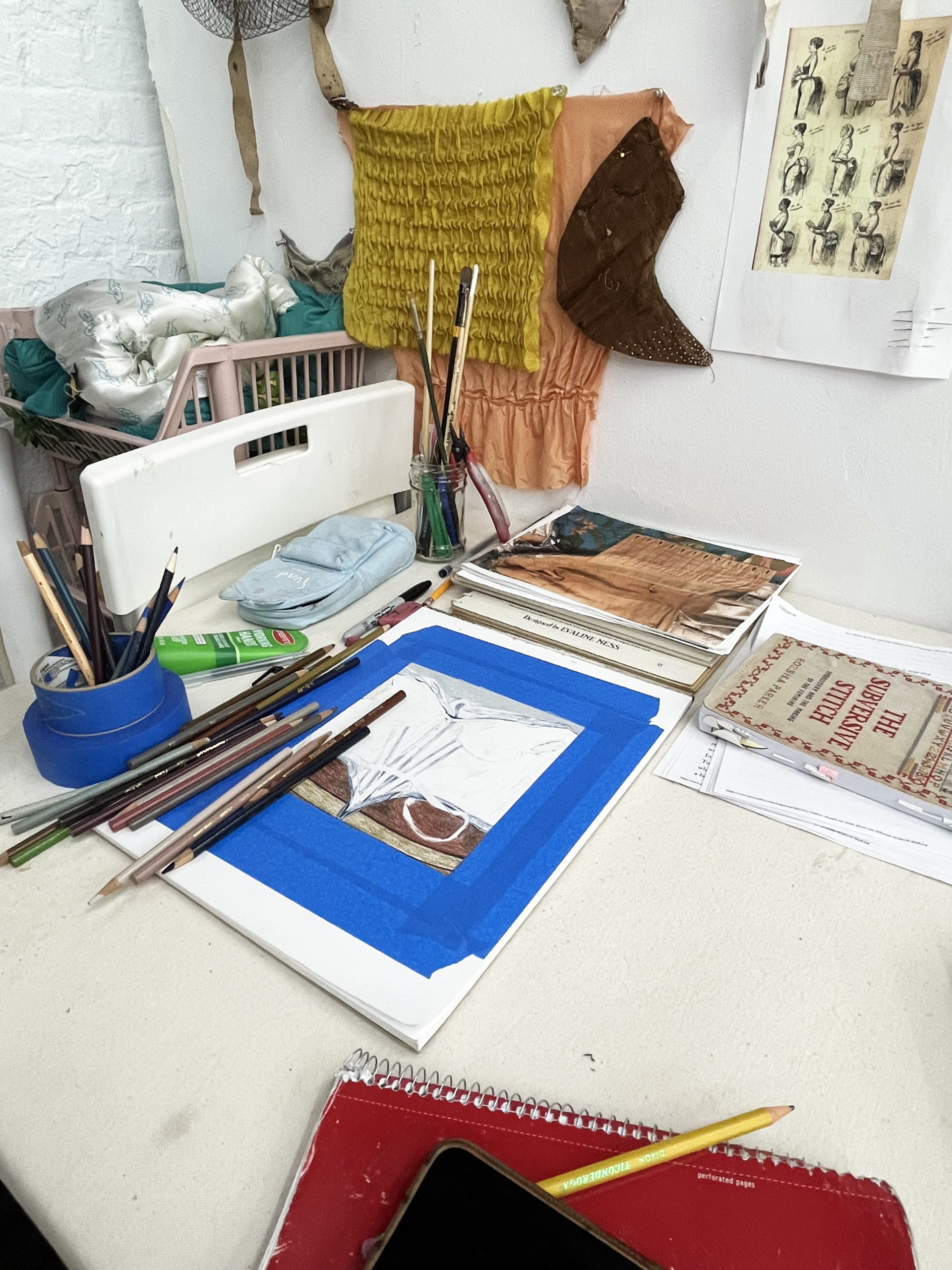The Femme Body and Performative Fashion with Martina Cox
Martina Cox’s studio is full with antique and vintage repurposed and disassembled fabrics; deconstructed corsets and penciled studies of period pieces hang on display along with neatly organized shelves showcasing secondhand fabrics to be used in future projects. Cox herself is not too worried about the state of the contemporary fashion world, but rather the craft and passion that goes into making garments without fast fashion intention. Together, we pored over the hand stitches that went into making women’s bodices of the 19th century; she pointed to an antique bustle that shaped the female body into something vastly different than what it ever could naturally be, and noted how the use of this material is not so different than the modern media’s desire to push for surgical body modification in women. There is an overall tone of reclamation within Cox’s work, especially with how influenced she is by 19th century garments that manipulate the femme-presenting body.
Cox explained how performing femininity plays a big part in how she designs her pieces, especially as the female presenting body is readily objectified in the media. In a way, her pieces reclaim this objectification of the femme form by studying them even further, removing them from sexual connotation and emphasizing the way the human body functions as a “support system” for clothing. Some of her older wearable work features miniature clay androgynous bodies hanging from their lining and when asked about them, Cox playfully called them, “clingy men” that use the garments (and perhaps the person wearing the garment) as a support system. Homemaking and the formation of craft is also a central theme within Cox’s garments. She pointed to a piece of floral fabric in her studio cupboards and noted how these textiles have very traditionally feminine associations. They are the textiles of housewives and homemakers that will be reworked into modern garments. They have what she calls, “baggage” despite being so unassuming to the general eye. Their history is what makes them even more significant than their overall pattern.
When asked about the creation process, it was fascinating to see how research and history driven Cox’s thinking is. She unshelved books such as, The Subversive Stitch by Rozsika Parker and cited influence from “The Yellow Wallpaper,” a short story by Charlotte Perkins Gilman, noting how her work is very much influenced by the history of textiles and handworking. Simultaneously, along with the general lower cost, Cox explained that she works with secondhand fabrics because she loves to consider the history of each piece: how they were touched by others, how they were used in the past, and how they are repurposed today. Fabric functions as more than just a means to make new things with, but also has been passed down through generations and holds its own history. Acknowledging this is an important part of Cox’s work as she remembers the way that her Italian grandmothers were constantly crafting with their hands, whether it be embroidery or hand stitching. This history is in part why Cox focuses on making her own work with her hands: as a love letter in acknowledgement to those before her who have done the same. Her eyes lit up when she spoke about the physicality of the act of embroidering: the embroiderer is physically surrendering themselves to their work by hunching over their art as they are in the making process. Her appreciation for the act of making and craft is admirable; she is unaffected by outside views about her creation process.

She laughed when the topic of childhood influence came up and cited long lost “Style.com”, as a primary source of inspiration as a child that led her to view fashion as a means of expression and specifically, performance. Cox recalls her childhood being filled with anxiety because of her desire to wear the most outlandish, random pieces to middle and high school. Her confidence exudes regardless of her insistence on this anxiety, which is an admirable quality of her performance pieces that often feature some aspect of “flashing” and interaction with the female form’s more intimate parts. Today, Cox cites the Italian designer, Elsa Schiaparelli’s work as a game changer for how she thinks about the interaction of art and clothing. Cox also emphasizes the impact that surrealism and its slow crawl into fashion beginning in the 1930’s has on her creation process.
At the moment, Cox is exploring the intimacy of hand stitching that went into creating 19th century women’s bodices. Referring to some deconstructed bodice studies she has hanging on her studio wall, Cox explained how fascinating it is that there is so much detail that goes into handcrafting the bodices despite the fact that barely anyone besides the wearer and the person who dressed them would get to see them. There lies an intimacy in handcrafting garments that is not present in machine made fast fashion. Once again emphasizing the value of the slow creation process, Cox is currently interested in natural dyeing and smocking textiles by hand.
Cox is the co-host alongside fellow AIR Hekima Hapa of the monthly meetup “Darn It!” at the Textile Arts Center, The first meeting was on Sunday, March 5th from 5 - 7pm. Textile Arts Center is also hosting AIR Open Studio on March 25th from 2 - 5pm. Come view the work of Martina Cox in person and meet the artists in residence of the Textile Arts Center.
Follow Martina @martinacox_ on instagram & Website: https://www.martinacox.com/
